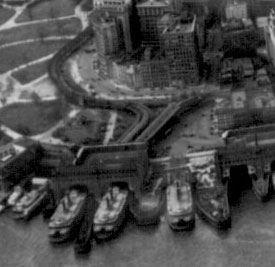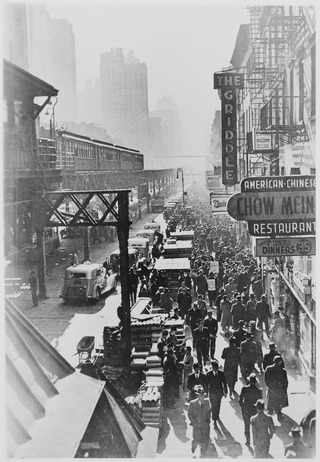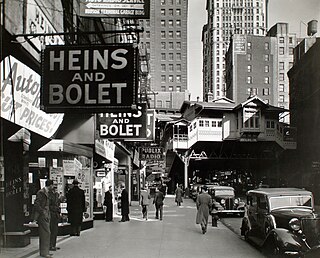Related Research Articles

The IRT Ninth Avenue Line, often called the Ninth Avenue Elevated or Ninth Avenue El, was the first elevated railway in New York City. It opened on July 3, 1868 as the West Side and Yonkers Patent Railway, as an experimental single-track cable-powered elevated railway from Battery Place, at the south end of Manhattan Island, northward up Greenwich Street to Cortlandt Street. It ceased operation on June 11, 1940, after it was replaced by the IND Eighth Avenue Line which had opened in 1932.

The IRT Third Avenue Line, commonly known as the Third Avenue Elevated, Third Avenue El, or Bronx El, was an elevated railway in Manhattan and the Bronx, New York City. Originally operated by the New York Elevated Railway, an independent railway company, it was acquired by the Interborough Rapid Transit Company (IRT) and eventually became part of the New York City Subway system.

The South Ferry station was an elevated station at the southern terminal of the IRT Second, Third, Sixth and Ninth Avenue Lines. It was located next to Battery Park at the lower tip of Manhattan, New York City. Two tracks came from the combined Second and Third Avenue Lines, and two from the Sixth and Ninth Avenue Lines, making four tracks at the terminal, with platforms on the outside and between each pair of tracks.

The Rector Street station is a station on the IRT Broadway–Seventh Avenue Line of the New York City Subway. Located at the intersection of Rector Street and Greenwich Street in Lower Manhattan, it is served by the 1 train at all times.
The IRT Jerome Avenue Line, also unofficially known as IRT Woodlawn Line and IRT Burnside Avenue Line is an A Division New York City Subway line mostly along Jerome Avenue in the Bronx. Originally an Interborough Rapid Transit Company-operated route, it was built as part of the Dual Contracts expansion and opened in 1917 and 1918. It is both elevated and underground, with 161st Street–Yankee Stadium being the southernmost elevated station. The line has three tracks from south of the Woodlawn station to the 138th Street–Grand Concourse station. The Woodlawn Line also has a connection to the Jerome Yard, where 4 trains are stored, just north of the Bedford Park Boulevard–Lehman College station.

The IRT Sixth Avenue Line, often called the Sixth Avenue Elevated or Sixth Avenue El, was the second elevated railway in Manhattan in New York City, following the Ninth Avenue Elevated.

The IRT Second Avenue Line, also known as the Second Avenue Elevated or Second Avenue El, was an elevated railway in Manhattan, New York City, United States, from 1878 to 1942. It was operated by the Interborough Rapid Transit Company until 1940, when the city took over the IRT. Service north of the 57th Street station ended on June 11, 1940; the rest of the line closed on June 13, 1942.

The Morris Park station is a station on the IRT Dyre Avenue Line of the New York City Subway served by the 5 train at all times. It is located at Paulding Avenue and the Esplanade in Morris Park, Bronx.

The South Ferry/Whitehall Street station is a New York City Subway station complex in the Financial District neighborhood of Manhattan, under Battery Park. The complex is shared by the IRT Broadway–Seventh Avenue Line and the BMT Broadway Line. It is served by the 1 and R trains at all times, the N train during late nights only, and the W train during weekdays only.

The 161st Street–Yankee Stadium station is a New York City Subway station complex shared by the elevated IRT Jerome Avenue Line and the underground IND Concourse Line. It is located at the intersection of 161st Street and River Avenue in the Highbridge and Concourse neighborhoods of the Bronx. It is generally served by the 4 train at all times; the D train at all times except rush hours in the peak direction ; and the B train during rush hours.
The Rector Street station was a station on the demolished IRT Ninth Avenue Line in Manhattan, New York City. It was built in 1874, and had two tracks and two side platforms, though two additional tracks ended at a bumper just south of the station. It was served by trains from the IRT Ninth Avenue Line, and was one block west of Rector Street El Station on the IRT Sixth Avenue Line. In 1918, the IRT extended what is today known as the Broadway–Seventh Avenue Line from Times Square down to South Ferry and built their own Rector Street station as one of the stations, serving as competition for the Ninth Avenue Line station. The el station closed on June 11, 1940. The next southbound stop was Battery Place. The next northbound stop was Cortlandt Street for Ninth Avenue Line trains.

The Cortlandt Street station was an express station at Greenwich Street on the demolished IRT Ninth Avenue Line in Manhattan, New York City. It was built as a replacement for the original southern terminus at Dey Street. It had three tracks, one island platform and two side platforms. It was served by trains from the IRT Ninth Avenue Line. It closed on June 11, 1940. The next southbound stop for all trains was Rector Street. The next northbound local stop was Barclay Street. The next northbound express stop was Warren Street.
The 66th Street station was an express station on the demolished IRT Ninth Avenue Line in Manhattan, New York City. It had two levels. The lower level was built first and had two tracks and two side platforms. The upper level was built as part of the Dual Contracts and had one track and two side platforms over the lower level local tracks. The station closed on June 11, 1940. The next southbound local stop was 59th Street. The next southbound express stop was 34th Street for Ninth Avenue trains, and 50th Street for IRT Sixth Avenue Line express trains. The next northbound local stop was 72nd Street. The next northbound express stop was 116th Street. The express run from this stop to 116th Street was the longest express segment out of all New York City elevated lines, bypassing seven local stations.
The 59th Street station was a local station on the demolished IRT Ninth Avenue Line in Manhattan, New York City. It had two levels. The lower level was built first and had two tracks and two side platforms that served local trains. The upper level was built as part of the Dual Contracts and had one track that served express trains. It closed on June 11, 1940. The next southbound stop was 50th Street for Ninth Avenue trains and Eighth Avenue for IRT Sixth Avenue Line trains. The next northbound stop was 66th Street.
The Rector Street station was on the demolished IRT Sixth Avenue Line in Manhattan, New York City. It had three tracks and two side platforms. It opened on June 5, 1878, served by trains from the IRT Sixth Avenue Line, and was one block east of Rector Street El Station on the IRT Ninth Avenue Line. In 1918, Brooklyn Rapid Transit Company built the Broadway Subway through Manhattan and added a station at Rector Street, which served as competition for the 6th Avenue Line station. The el station closed on December 4, 1938. The next southbound stop was Battery Place on the IRT Ninth Avenue Line. The next northbound stop was Cortlandt Street.

The Cortlandt Street station was a station at Church Street on the demolished IRT Sixth Avenue Line in Manhattan, New York City. It had 3 tracks and two side platforms. It was served by trains from the IRT Sixth Avenue Line and opened on June 5, 1878. It closed on December 4, 1938. The next southbound stop was Rector Street. The next northbound stop was Park Place.

The Park Place station was a station on the demolished IRT Sixth Avenue Line in Manhattan, New York City. It had 2 tracks and two side platforms. It was served by trains from the IRT Sixth Avenue Line and opened on June 5, 1878. It closed on December 4, 1938. The next southbound stop was Cortlandt Street for local trains, and Battery Place for express trains. The next northbound stop was Chambers Street for all trains. The Chambers Street – World Trade Center / Park Place station complex can be found within the vicinity of the former elevated railroad station.
The 53rd Street and Eighth Avenue station was a station on the demolished IRT Sixth Avenue Line in Manhattan, New York City. It was built in 1881 by the Manhattan Railway Company as part of an effort to connect the northern end of the Sixth Avenue Line to the Ninth Avenue Line. It had three tracks and two side platforms, and was served by trains from the IRT Sixth Avenue Line. As a result, it became the last station on the Sixth Avenue Line before merging at a sharp curve with the Ninth Avenue Line. On September 11, 1905, 12 people were killed and 42 injured when a train jumped over the rails at the curve on 53rd Street between the Ninth Avenue 50th Street and 59th Street stations. In 1932, the Independent Subway System built the 50th Street Station three blocks to the south on the Eighth Avenue Subway with an additional lower level in 1933, thus rendering the elevated station and line obsolete. It closed on December 4, 1938. The next southbound stop was 50th Street. The next northbound stop was 59th Street.
References
- ↑ "A Station at Battery Place". New York Times. June 5, 1883. p. 5. Retrieved September 22, 2020.
- ↑ "Tonight to See City Pass Goal of Unification". New York Daily News . June 10, 1940. p. 37. Retrieved June 30, 2019– via Newspapers.com.

- ↑ "A Station at Battery Place". New York Times. June 5, 1883. p. 5. Retrieved September 22, 2020.